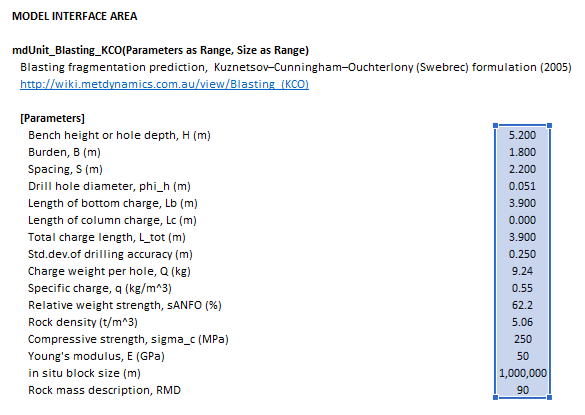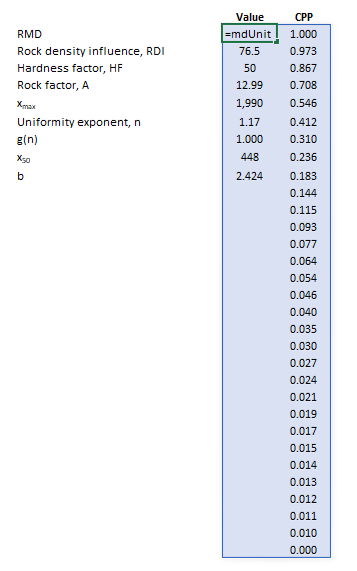Blasting (KCO): Difference between revisions
Jump to navigation
Jump to search
Scott Munro (talk | contribs) m (1 revision imported) |
md>Scott.Munro m (→Inputs) |
||
| Line 8: | Line 8: | ||
== Excel == | == Excel == | ||
The KOC blasting model may be invoked from the Excel formula bar with the following function call: | The KOC blasting model may be invoked from the Excel formula bar with the following function call: | ||
| Line 17: | Line 15: | ||
{{Excel (Text, Help, No Arguments)}} | {{Excel (Text, Help, No Arguments)}} | ||
== | === Inputs === | ||
{{Excel (Text, Inputs)}} | |||
:<math>Parameters= | |||
\begin{bmatrix} | |||
H\text{ (m)}\\ | |||
B\text{ (m)}\\ | |||
S\text{ (m)}\\ | |||
\phi_{\rm h}\text{ (m)}\\ | |||
L_{\rm b}\text{ (m)}\\ | |||
L_{\rm c}\text{ (m)}\\ | |||
L_{\rm Tot}\text{ (m)}\\ | |||
\sigma\text{ (m)}\\ | |||
Q\text{ (kg)}\\ | |||
q\text{ (kg/m}^3\text{)}\\ | |||
s_{\rm ANFO}\text{ (}%\text{)}\\ | |||
\rho\text{ (t/m}^3\text{)}\\ | |||
\sigma_{\rm c}\text{ (MPa)}\\ | |||
E\text{ (GPa)}\\ | |||
\text{In-situ block size (m)}\\ | |||
\text{RMD}\\ | |||
\end{bmatrix},\;\;\;\;\;\; | |||
Size = \begin{bmatrix} | |||
d_{1}\text{ (mm)}\\ | |||
\vdots\\ | |||
d_n\text{ (mm)}\\ | |||
\end{bmatrix} | |||
</math> | |||
where: | |||
* <math>H</math> is the bench height or hole depth (m) | |||
* <math>B</math> is Burden (m) | |||
* <math>S</math> is Spacing (m) | |||
* <math>\phi_{\rm h}</math> is drill hole diameter (m) | |||
* <math>L_{\rm b}</math> is the length of bottom charge (m) | |||
* <math>L_{\rm c}</math> is the length of column charge (m) | |||
* <math>L_{\rm Tot}</math> is the total charge length, (m) | |||
* <math>\sigma</math> is the standard deviation drilling accuracy (m) | |||
* <math>Q</math> is Charge weight per hole (kg) | |||
* <math>q</math> is Specific charge (kg/m<sup>3</sup>) | |||
* <math>s_{\rm ANFO}</math> is ANFO relative weight strength (%) | |||
* <math>\rho</math> is rock density (t/m<sup>3</sup>) | |||
* <math>\sigma_{\rm c}</math> is compressive strength (MPa) | |||
* <math>E</math> is Young's modulus (GPa) | |||
* <math>\text{In-situ block size}</math> is in situ block size (m) | |||
* <math>\text{RMD}</math> is Rock Mass Description | |||
* <math>n</math> is the number of size intervals | |||
* <math>d_i</math> is the size of the square mesh interval that mass is retained on (mm) | |||
* <math>d_{i+1}<d_i<d_{i-1}</math>, i.e. descending size order from top size (<math>d_{1}</math>) to sub mesh (<math>d_{n}=0</math> mm) | |||
=== Results === | |||
The results are displayed in Excel as an array corresponding to the matrix notation below: | |||
:<math> | |||
\mathit{mdUnit\_Blasting\_KCO} = \begin{bmatrix} | |||
\begin{bmatrix} | |||
\text{RMD}\\ | |||
H_{\rm f}\\ | |||
x_{\rm Max}\text{ (mm)}\\ | |||
n\\ | |||
g(h)\\ | |||
x_{50}\text{ (mm)}\\ | |||
b\\ | |||
\end{bmatrix} | |||
& | |||
\begin{array}{c} | |||
\begin{bmatrix} | |||
\mathit{CFP}_1\text{ (w/w)}\\ | |||
\vdots\\ | |||
\mathit{CFP}_n\text{ (w/w)} | |||
\end{bmatrix} | |||
\\ | |||
\\ | |||
\\ | |||
\\ | |||
\end{array} | |||
\end{bmatrix} | |||
</math> | |||
where: | |||
* <math>H_{\rm f}</math> is the hardness factor | |||
* <math>x_{\rm Max}</math> is the maximum size parameter of the Swebrec function (mm) | |||
* <math>n</math> is the uniformity exponent parameter of the Swebrec function | |||
* <math>g(n)</math> is a function parameter of the Swebrec function | |||
* <math>x_{\rm 50}</math> is the mean size parameter of the Swebrec function (mm) | |||
* <math>b</math> is an exponent parameter of the Swebrec function | |||
* <math>\mathit{CFP}_i</math> is the cumulative fraction passing size interval <math>i</math> (w/w) | |||
=== Example === | |||
The images below show the selection of input arrays and output results in the Excel interface. | |||
{ | {| | ||
|- style="vertical-align:top;" | |||
| [[File:BlastingKCO1.png|left|frame|Figure 1. Example showing the selection of the '''Parameters''' (blue frame) array in Excel.]] | |||
| [[File:BlastingKCO2.png|left|frame|Figure 2. Example showing the selection of the '''Size''' (red frame) array in Excel.]] | |||
| [[File:BlastingKCO3.png|left|frame|Figure 3. Example showing the selection of the '''Results''' (light blue frame) array in Excel.]] | |||
|} | |||
== References == | == References == | ||
[[Category:Excel]] | [[Category:Excel]] | ||
Revision as of 08:35, 15 May 2023
Description
This article describes the Kuznetsov–Cunningham–Ouchterlony (KCO) model (Ouchterlony, 2005), also known as the Swebrec function, for predicting rock fragmentation by blasting.[1]
Model theory
Excel
The KOC blasting model may be invoked from the Excel formula bar with the following function call:
=mdUnit_Blasting_KCO(Parameters as Range, Size as Range)
Invoking the function with no arguments will print Help text associated with the model, including a link to this page.
Inputs
The required inputs are defined below in matrix notation with elements corresponding to cells in Excel row () x column () format:
where:
- is the bench height or hole depth (m)
- is Burden (m)
- is Spacing (m)
- is drill hole diameter (m)
- is the length of bottom charge (m)
- is the length of column charge (m)
- is the total charge length, (m)
- is the standard deviation drilling accuracy (m)
- is Charge weight per hole (kg)
- is Specific charge (kg/m3)
- is ANFO relative weight strength (%)
- is rock density (t/m3)
- is compressive strength (MPa)
- is Young's modulus (GPa)
- is in situ block size (m)
- is Rock Mass Description
- is the number of size intervals
- is the size of the square mesh interval that mass is retained on (mm)
- , i.e. descending size order from top size () to sub mesh ( mm)
Results
The results are displayed in Excel as an array corresponding to the matrix notation below:
where:
- is the hardness factor
- is the maximum size parameter of the Swebrec function (mm)
- is the uniformity exponent parameter of the Swebrec function
- is a function parameter of the Swebrec function
- is the mean size parameter of the Swebrec function (mm)
- is an exponent parameter of the Swebrec function
- is the cumulative fraction passing size interval (w/w)
Example
The images below show the selection of input arrays and output results in the Excel interface.
References
- ↑ Ouchterlony, F., 2005. The Swebrec© function: linking fragmentation by blasting and crushing. Mining Technology, 114(1), pp.29-44.

































